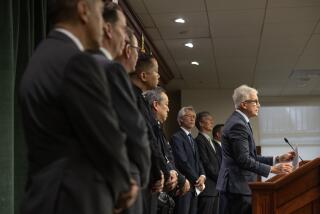Trial Ordered for Suspect in 1982 Killing of CSUN Worker : Courts: The testimony of a woman dying of cancer persuades a judge that a Minnesota man should be tried in the slaying of the college administrator.
- Share via
Relying heavily on the testimony of a dying prosecution witness, a judge on Thursday ordered a Minnesota man to stand trial in the slaying of a Cal State Northridge administrator nine years ago.
Jonathan Karl Lundh, 39, was charged six months ago with the 1982 death in Burbank of Patty Lynne Cohen, 40, assistant to the dean of CSUN’s School of Arts.
Cohen, whose slaying drew widespread media attention at the time, was last seen leaving an evening self-improvement seminar at the Burbank Holiday Inn.
Prosecutors revived the case this year because their key witness, who has recently been told that she is dying of cancer, informed Los Angeles police that she now is positive Lundh was the man she saw driving the victim’s car shortly after the killing.
In 1982, the witness, elementary school teacher Rain Slook, told police after viewing Lundh in a lineup that she had “strong feelings” he was the man, but she also wrote on a witness card, “I am not positive.”
Based largely on Slook’s statement, investigators in 1982 abandoned plans to charge Lundh with murder.
However, they did charge him with attempting to kidnap another woman from the Holiday Inn parking lot on the same evening that Cohen was killed. He was convicted of that crime and sentenced to four years in prison.
In his ruling Thursday, Municipal Judge Michael S. Luros, who presided over a six-week preliminary hearing in the case, said he placed great weight on Slook’s testimony and on the testimony of the victim of the attempted abduction, who again identified Lundh as her assailant.
“The fact is that Rain Slook saw the defendant driving the vehicle,” Luros said.
In a dramatic court appearance last month, a trembling, wheelchair-bound Slook addressed Lundh from the witness stand, saying:
“I do not expect to be around much longer. I had to face you and you had to face me.”
Lundh, who represented himself at the hearing, repeatedly demanded during cross-examination that Slook explain how she can identify him now but could not do so in 1982.
Slook said she was intimidated by officials at the 1982 lineup and “felt no one was going to believe me . . . because I only had a peripheral view” of the man driving Cohen’s car.
At one point in their tense, 90-minute exchange, Slook shot back at Lundh: “I made a mistake that day. I should have said yes.”
Slook said she took note of the driver of the car on Sherman Way because its license plate seemed similar to one belonging to a friend. Several days later she connected the incident to news photos of the dead woman’s white Mustang and contacted police, Slook said.
Slook also said she told investigators that she now was willing to identify Lundh “because I only have three to six months to live, and I have to finish up this business.”
At the request of Deputy Dist. Atty. Phillip H. Rabichow, Luros ordered Slook’s testimony videotaped so that it can be played for a trial jury if she dies or is too weak to come to court.
In his final argument, Lundh noted that there was no physical evidence--”no hair, no fibers, no prints, nothing”--linking him to Cohen’s car.
“All they have are identifications of me that were coerced and pressured,” he said.
Detectives testified during the hearing that the case was dormant for seven years until other investigators began studying it because of its similarity to another murder.
North Hollywood Division detectives, who had jurisdiction because Cohen’s body was found in the trunk of her car in an alley there, decided to re-interview Lundh and major witnesses, including Slook.
Police said they located Lundh in his native St. Paul, Minn., where he was convicted of grand theft after being paroled in California.
More to Read
Sign up for Essential California
The most important California stories and recommendations in your inbox every morning.
You may occasionally receive promotional content from the Los Angeles Times.













